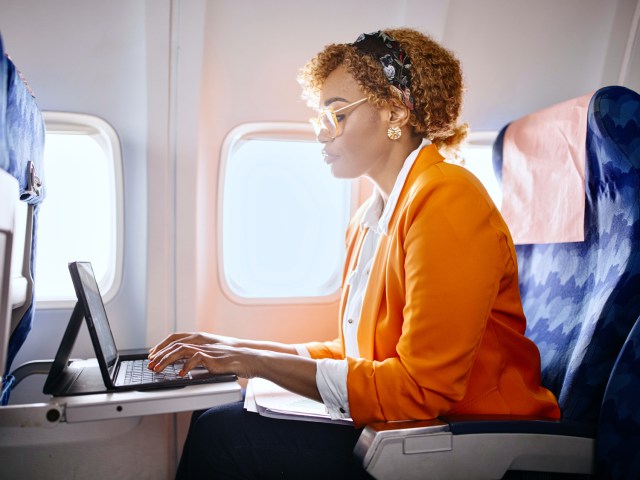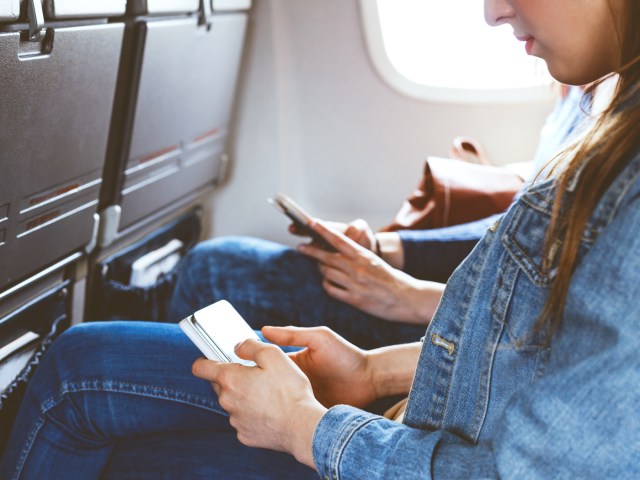Having access to Wi-Fi in the air is increasingly a high priority for travelers. Getting online is now so much a part of our everyday lives that many of us are loath to put that on pause, even for a few hours in the sky. Many passengers are willing to pay for in-flight Wi-Fi, yet the speeds are often excruciatingly slow. So, what’s the problem — why is airplane Wi-Fi so bad? And do certain airlines provide better Wi-Fi than others? Read below to find out.
Growing Demand for In-Flight Wi-Fi

Due to the widespread use of smartphones, airlines have seen the demand for Wi-Fi grow substantially over the past decade or so. Instead of a relatively small number of business travelers checking emails, carriers now have to contend with a much higher number of passengers expecting online access for a much wider range of activities.
According to in-flight Wi-Fi provider ViaSat’s 2023 Passenger Experience Survey, connectivity during a flight is now less of a “would like” and more a “must have,” with 83% of respondents saying they’d rebook with an airline for better Wi-Fi. They also found that free in-flight WiFi is now second only to the cost of the ticket in influencing booking decisions, beating factors such as legroom and in-flight catering.
Challenges Connecting in the Air

Getting everyone connected is a costly business, partly because of the challenges created by being 35,000 feet up in the air and traveling at speeds over 500 mph. There are two main methods of supplying in-flight Wi-Fi to passengers. The first is the air-to-ground system, and the second relies on the use of satellites.
With air-to-ground systems, antennas underneath the plane receive a signal from ground-based towers and relay it to the onboard server. Gogo, a popular in-flight Wi-Fi provider, uses this type of system and offers complete coverage of the contiguous U.S. An advantage of an air-to-ground system is low latency — that is, how long the signal takes to travel. However, these signals typically have very limited bandwidth — typically around five megabits per second, compared with about 30 megabits per second for mobile broadband. As dozens of passengers try to share the already limited bandwidth, that can have a significant impact on the quality and speed of the connection.
The other method of getting connected is the satellite system. It’s more expensive than an air-to-ground system, but satellites are capable of carrying far more data, resulting in faster speeds for users. Although coverage is greater, the number of satellites can still place limits on bandwidth. Traditionally, latency has been more of an issue as the plane’s antenna must reach a target more than 22,000 miles above the Earth. As the plane is moving at a high speed, the antenna’s position has to be adjusted constantly to maintain contact with the satellite station. However, the rollout of Starlink’s high-speed, low-latency offering is set to improve speeds even further.
How Does Wi-Fi on U.S. Airlines Compare?

While passengers have dealt with slow speeds in the skies for quite some time, things are looking up, and U.S.-based airlines are investing millions of dollars to improve their offerings. ViaSat has been enabling JetBlue’s FlyFi for more than a decade, and best of all, it’s free for all customers. However, the customer experience isn’t consistent across all routes. Service is best over the contiguous U.S., while the system’s “extended coverage” over the Caribbean, Central America, and the Atlantic is available only on certain plane types.
Delta, meanwhile, has reportedly invested $1 billion launching Delta Sync, an initiative to bring fast, free Wi-Fi to all passengers thanks to the airline’s partnership with T-Mobile. The rollout is well underway, and Delta hopes to achieve 90% connectivity (based on total available seat miles) by the end of 2024. Southwest Airlines has also recently upgraded its entire fleet with the latest-generation hardware, promising speeds up to 10 times faster than before, for a flat fee of $8 per flight. Alaska Airlines offers satellite Wi-Fi fast enough to stream entertainment on most flights for $8.
United Airlines offers some flights with upgraded speeds (starting at $8), but still has a mix of providers depending on aircraft, and that includes slower air-to-ground systems. Similarly, American also has upgraded high-speed satellite Wi-Fi on most routes (starting at $10), but some planes still feature the older system as of mid-2024.
In February 2024, Hawaiian Airlines announced that it had become the first major carrier to adopt Starlink’s high-speed broadband system. The system will be deployed across the Airbus A321neo aircraft in the fleet and is being offered as a complimentary service to all passengers. Overall, as airlines try to keep pace with demand and expectations, the future of in-flight WiFi looks a lot more promising.
More from our network
Daily Passport is part of Inbox Studio, which publishes content that uplifts, informs, and inspires.
















